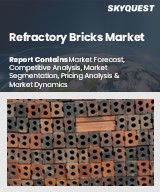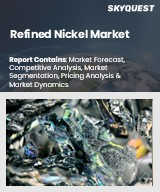
|
시장보고서
상품코드
1679567
직접환원철(DRI) 시장 규모, 점유율, 동향 분석 보고서(2025-2030년) : 최종 용도별, 형태별, 지역별 부문 예측Direct Reduced Iron Market Size, Share & Trends Analysis Report, By End-use (Steelmaking), By Form (Cold Direct Reduced Iron, Hot Direct Reduced Iron, Hot Briquetted Iron), By Region (North America, Europe, APAC), And Segment Forecasts, 2025 - 2030 |
||||||
직접환원철(DRI) 시장의 성장과 동향
Grand View Research, Inc.의 최신 보고서에 따르면 세계의 직접환원철(DRI) 시장 규모는 2030년까지 689억 8,000만 달러에 달할 것으로 예측되고, 2025-2030년의 CAGR은 7.1%를 나타낼 것으로 예측됩니다. 해면철로도 알려진 DRI는 철강 생산 가운데 특히 전기로(EAF)에서 사용되는 중요한 원료입니다. 신흥국을 중심으로 세계의 도시화와 산업화가 가속화되고 있는 가운데, 철강 요구가 급증하면서 DRI 수요를 밀어 올리고 있습니다. 신흥국이 인프라 프로젝트에 많은 투자를 하고 시장 성장을 더욱 뒷받침하고 있기 때문에 이 동향은 앞으로도 계속될 것으로 예상됩니다.
종래의 고로 제강법은 탄소 집약도가 높아 온실가스의 배출에 크게 기여하고 있습니다. 이와는 대조적으로, DRI 생산은 특히 재생 가능한 에너지원이나 천연가스와 결합하여 CO2 배출량을 상당히 줄일 수 있습니다. 세계 정부와 산업이 보다 엄격한 환경 규제를 채택하고 탄소 발자국을 줄이기 위해 보다 깨끗한 제강 공정으로의 전환을 가속하고 있습니다. 이러한 이유로 DRI는 보다 지속 가능한 대체품으로 자리매김하고 있으며, 그 채용과 시장 성장의 원동력이 되고 있습니다.
DRI 생산 공정에서의 기술적 진보는 또한 시장 확대에 중요한 역할을 합니다. 가스 및 석탄 기반 DRI 기술의 혁신은 생산 효율, 비용 효율성 및 확장성을 개선했습니다. 예를 들어, 첨단 가스 기반 환원 기술의 개발은 경제적으로 실행 가능하고 친환경 천연 가스를 환원제로 사용할 수 있게 되었습니다. 이러한 기술 개선으로 보다 폭넓은 철강 제조업체들이 DRI 생산을 이용하기 쉬워지면서 시장의 성장을 더욱 자극하고 있습니다.
특히 중동이나 북미와 같은 지역에서 풍부한 천연가스 자원을 이용할 수 있는 것도 직접환원철 산업의 큰 성장요인이 되고 있습니다. 천연가스는 가스 기반 DRI 생산의 주요 투입 자원이며, 이 지역에서는 비용이 상대적으로 낮기 때문에 DRI 생산이 경제적으로 매력적입니다. 또한 미국의 셰일 가스 붐은 DRI 생산의 경쟁력을 더욱 높여 풍부한 천연 가스 확보로 이어지고 있습니다. 이는 DRI 플랜트에 대한 투자를 촉진하고 이 지역에서 시장 확대를 지원합니다.
직접환원철(DRI) 시장 보고서 하이라이트
- 최종 용도별로 건설, 자동차, 그리고 인프라 프로젝트에서 철강 수요가 증가함에 따라 2024년에는 제강 부문이 83.8%의 최대 수익 점유율로 시장을 선도했습니다. 이 동향은 세계적으로 도시화와 산업화가 가속화됨에 따라 계속될 것으로 예상됩니다.
- 형태별로는 냉간직접환원철(CDRI) 부문이 2024년에 78.8%의 최대 수익 점유율로 시장을 선도했습니다. CDRI 수요는 종래의 제법에 비해 적은 탄소 배출량 등 환경면에서의 이점도 뒷받침하고 있습니다.
- 아시아태평양은 강력한 산업 기반, 급속한 도시화, 높은 철강 생산 능력을 배경으로 2024년의 수익 점유율이 56.8%로 가장 높았고 시장을 독점하고 있습니다.
목차
제1장 조사 방법과 범위
제2장 주요 요약
제3장 시장의 변수, 동향, 범위
- 세계의 직접환원철(DRI) 시장 전망
- 산업 밸류체인 분석
- 유통 채널 분석
- 기술 개요
- 규제 프레임워크
- 시장 역학
- 시장 성장 촉진요인 분석
- 시장 성장 억제요인 분석
- 시장 기회 분석
- 시장의 과제
- Porter's Five Forces 분석
- 공급자의 협상력
- 구매자의 협상력
- 대체 위협
- 신규 참가업체의 위협
- 경쟁 기업간 경쟁 관계
- PESTLE 분석
- 정치
- 경제
- 사회
- 기술
- 환경
- 법률
제4장 직접환원철(DRI) 시장 : 최종 용도별, 추정 및 동향 분석
- 직접환원철(DRI) 시장 : 최종 용도 변동 분석(2024년 및 2030년)
- 제철
- 기타
제5장 직접환원철(DRI) 시장 : 형태별, 추정 및 동향 분석
- 직접환원철(DRI) 시장 : 형태변동 분석(2024년 및 2030년)
- 냉간직접환원철(CDRI)
- 열간직접환원철(CDRI)
- 열간브리켓철(HBI)
제6장 직접환원철(DRI) 시장 : 지역별, 추정 및 동향 분석
- 지역 분석(2024년 및 2030년)
- 북미
- 최종 용도별(2018-2030년)
- 형태별(2018-2030년)
- 미국
- 캐나다
- 멕시코
- 유럽
- 최종 용도별(2018-2030년)
- 형태별(2018-2030년)
- 독일
- 스페인
- 이탈리아
- 아시아태평양
- 최종 용도별(2018-2030년)
- 형태별(2018-2030년)
- 중국
- 인도
- 일본
- 중남미
- 최종 용도별(2018-2030년)
- 형태별(2018-2030년)
- 아르헨티나
- 중동 및 아프리카
- 최종 용도별(2018-2030년)
- 형태별(2018-2030년)
제7장 경쟁 구도
- 주요 시장 진출기업에 의한 최근 동향과 영향 분석
- 기업 분류
- 히트맵 분석
- 벤더 상황
- 장비 공급업체 목록
- 유통업체 일람
- 잠재적 최종 사용자 목록
- 전략 이니셔티브
- 기업 프로파일/상장 기업
- Qatar Steel
- Kobe Steel Ltd
- ArcelorMittal
- Ghadir Iron and Steel Company
- Khorasan Steel II
- NUCOR
- Khouzestan Steel Company
- Welspun Group
- Jindal Shadeed Iron & Steel LLC
- AM/NS India
- Tosyali Algeria AS
Direct Reduced Iron Market Growth & Trends:
The global direct reduced iron market size is anticipated to reach USD 68.98 billion by 2030 and is projected to grow at a CAGR of 7.1% from 2025 to 2030, according to a new report by Grand View Research, Inc. DRI, also known as sponge iron, is a critical raw material used in steel production, particularly in electric arc furnaces (EAFs). As global urbanization and industrialization accelerate, particularly in emerging economies, the need for steel has surged, boosting the demand for DRI. This trend is expected to continue as developing nations invest heavily in infrastructure projects, further propelling market growth.
Traditional blast furnace steelmaking methods are highly carbon-intensive, contributing significantly to greenhouse gas emissions. In contrast, DRI production emits considerably lower levels of CO2, especially when paired with renewable energy sources or natural gas. The shift toward cleaner steelmaking processes has gained momentum as governments and industries worldwide adopt stricter environmental regulations and aim to reduce carbon footprints. This has positioned DRI as a more sustainable alternative, driving its adoption and market growth.
Technological advancements in DRI production processes have also played a crucial role in market expansion. Innovations in gas- and coal-based DRI technologies have improved production efficiency, cost-effectiveness, and scalability. For instance, developing advanced gas-based reduction technologies has enabled using natural gas as a reducing agent, which is both economically viable and environmentally friendly. These technological improvements have made DRI production more accessible to a wider range of steel manufacturers, further stimulating market growth.
The availability of abundant natural gas resources, particularly in regions like the Middle East and North America, has also been a significant growth driver for the direct reduced iron industry. Natural gas is a key input in gas-based DRI production, and its relatively low cost in these regions has made DRI production more economically attractive. In addition, the shale gas boom in the U.S. has further enhanced the competitiveness of DRI production, leading to a surplus of affordable natural gas. This has encouraged investments in DRI plants and supported the market's expansion in these regions.
Direct Reduced Iron Market Report Highlights:
- Based on end use, the steelmaking segment led the market with the largest revenue share of 83.8% in 2024, due to the growing demand for steel in construction, automotive, and infrastructure projects. This trend is expected to continue as urbanization and industrialization accelerate globally.
- Based on form, the cold direct reduced iron (CDRI) segment led the market with the largest revenue share of 78.8% in 2024, driven by its increasing use in steelmaking due to its high efficiency and cost-effectiveness. The demand for CDRI is also boosted by its environmental benefits, such as lower carbon emissions compared to traditional methods.
- Asia Pacific is the dominant the market with the largest revenue share of 56.8% in 2024, due to the region's strong industrial base, rapid urbanization, and high steel production capacity.
Table of Contents
Chapter 1. Methodology and Scope
- 1.1. Market Segmentation & Scope
- 1.2. Market Definition
- 1.3. Information Procurement
- 1.3.1. Information Analysis
- 1.3.2. Data Analysis Models
- 1.3.3. Market Formulation & Data Visualization
- 1.3.4. Data Validation & Publishing
- 1.4. Research Scope and Assumptions
- 1.4.1. List of Data Sources
Chapter 2. Executive Summary
- 2.1. Market Outlook
- 2.2. Segmental Outlook
- 2.3. Competitive Outlook
Chapter 3. Market Variables, Trends, and Scope
- 3.1. Global Direct Reduced Iron Market Outlook
- 3.2. Industry Value Chain Analysis
- 3.2.1. Sales Channel Analysis
- 3.3. Technology Overview
- 3.4. Regulatory Framework
- 3.5. Market Dynamics
- 3.5.1. Market Driver Analysis
- 3.5.2. Market Restraint Analysis
- 3.5.3. Market Opportunity Analysis
- 3.5.4. Market Challenges
- 3.6. Porter's Five Forces Analysis
- 3.6.1. Bargaining Power of Suppliers
- 3.6.2. Bargaining Power of Buyers
- 3.6.3. Threat of Substitution
- 3.6.4. Threat of New Entrants
- 3.6.5. Competitive Rivalry
- 3.7. PESTLE Analysis
- 3.7.1. Political
- 3.7.2. Economic
- 3.7.3. Social Landscape
- 3.7.4. Technology
- 3.7.5. Environmental
- 3.7.6. Legal
Chapter 4. Direct Reduced Iron Market: End Use Estimates & Trend Analysis
- 4.1. Direct Reduced Iron Market: End Use Movement Analysis, 2024 & 2030
- 4.2. Steelmaking
- 4.2.1. Market estimates and forecasts, 2018 - 2030 (USD Million) (Kilotons)
- 4.3. Others
- 4.3.1. Market estimates and forecasts, 2018 - 2030 (USD Million) (Kilotons)
Chapter 5. Direct Reduced Iron Market: Form Estimates & Trend Analysis
- 5.1. Direct Reduced Iron Market: Form Movement Analysis, 2024 & 2030
- 5.2. Cold Direct Reduced Iron (CDRI)
- 5.2.1. Market estimates and forecasts, 2018 - 2030 (USD Million) (Kilotons)
- 5.3. Hot Direct Reduced Iron (CDRI)
- 5.3.1. Market estimates and forecasts, 2018 - 2030 (USD Million) (Kilotons)
- 5.4. Hot Briquetted Iron (HBI)
- 5.4.1. Market estimates and forecasts, 2018 - 2030 (USD Million) (Kilotons)
Chapter 6. Direct Reduced Iron Market: Regional Estimates & Trend Analysis
- 6.1. Regional Analysis, 2024 & 2030
- 6.2. North America
- 6.2.1. Market estimates and forecasts, 2018 - 2030 (USD Million) (Kilotons)
- 6.2.2. Market estimates and forecasts, by end use, 2018 - 2030 (USD Million) (Kilotons)
- 6.2.3. Market estimates and forecasts, by form, 2018 - 2030 (USD Million) (Kilotons)
- 6.2.4. U.S.
- 6.2.4.1. Market estimates and forecasts, by end use, 2018 - 2030 (USD Million) (Kilotons)
- 6.2.4.2. Market estimates and forecasts, by form, 2018 - 2030 (USD Million) (Kilotons)
- 6.2.5. Canada
- 6.2.5.1. Market estimates and forecasts, by end use, 2018 - 2030 (USD Million) (Kilotons)
- 6.2.5.2. Market estimates and forecasts, by form, 2018 - 2030 (USD Million) (Kilotons)
- 6.2.6. Mexico
- 6.2.6.1. Market estimates and forecasts, by end use, 2018 - 2030 (USD Million) (Kilotons)
- 6.2.6.2. Market estimates and forecasts, by form, 2018 - 2030 (USD Million) (Kilotons)
- 6.3. Europe
- 6.3.1. Market estimates and forecasts, 2018 - 2030 (USD Million) (Kilotons)
- 6.3.2. Market estimates and forecasts, by end use, 2018 - 2030 (USD Million) (Kilotons)
- 6.3.3. Market estimates and forecasts, by form, 2018 - 2030 (USD Million) (Kilotons)
- 6.3.4. Germany
- 6.3.4.1. Market estimates and forecasts, by end use, 2018 - 2030 (USD Million) (Kilotons)
- 6.3.4.2. Market estimates and forecasts, by form, 2018 - 2030 (USD Million) (Kilotons)
- 6.3.5. Spain
- 6.3.5.1. Market estimates and forecasts, by end use, 2018 - 2030 (USD Million) (Kilotons)
- 6.3.5.2. Market estimates and forecasts, by form, 2018 - 2030 (USD Million) (Kilotons)
- 6.3.6. Italy
- 6.3.6.1. Market estimates and forecasts, by end use, 2018 - 2030 (USD Million) (Kilotons)
- 6.3.6.2. Market estimates and forecasts, by form, 2018 - 2030 (USD Million) (Kilotons)
- 6.4. Asia Pacific
- 6.4.1. Market estimates and forecasts, 2018 - 2030 (USD Million) (Kilotons)
- 6.4.2. Market estimates and forecasts, by end use, 2018 - 2030 (USD Million) (Kilotons)
- 6.4.3. Market estimates and forecasts, by form, 2018 - 2030 (USD Million) (Kilotons)
- 6.4.4. China
- 6.4.4.1. Market estimates and forecasts, by end use, 2018 - 2030 (USD Million) (Kilotons)
- 6.4.4.2. Market estimates and forecasts, by form, 2018 - 2030 (USD Million) (Kilotons)
- 6.4.5. India
- 6.4.5.1. Market estimates and forecasts, by end use, 2018 - 2030 (USD Million) (Kilotons)
- 6.4.5.2. Market estimates and forecasts, by form, 2018 - 2030 (USD Million) (Kilotons)
- 6.4.6. Japan
- 6.4.6.1. Market estimates and forecasts, by end use, 2018 - 2030 (USD Million) (Kilotons)
- 6.4.6.2. Market estimates and forecasts, by form, 2018 - 2030 (USD Million) (Kilotons)
- 6.5. Central & South America
- 6.5.1. Market estimates and forecasts, 2018 - 2030 (USD Million) (Kilotons)
- 6.5.2. Market estimates and forecasts, by end use, 2018 - 2030 (USD Million) (Kilotons)
- 6.5.3. Market estimates and forecasts, by form, 2018 - 2030 (USD Million) (Kilotons)
- 6.5.4. Argentina
- 6.5.4.1. Market estimates and forecasts, by end use, 2018 - 2030 (USD Million) (Kilotons)
- 6.5.4.2. Market estimates and forecasts, by form, 2018 - 2030 (USD Million) (Kilotons)
- 6.6. Middle East & Africa
- 6.6.1. Market estimates and forecasts, 2018 - 2030 (USD Million) (Kilotons)
- 6.6.2. Market estimates and forecasts, by end use, 2018 - 2030 (USD Million) (Kilotons)
- 6.6.3. Market estimates and forecasts, by form, 2018 - 2030 (USD Million) (Kilotons)
Chapter 7. Competitive Landscape
- 7.1. Recent Developments & Impact Analysis, By Key Market Participants
- 7.2. Company Categorization
- 7.3. Heat Map Analysis
- 7.4. Vendor Landscape
- 7.4.1. List of equipment suppliers
- 7.4.2. List of distributors
- 7.5. List of prospective end-users
- 7.6. Strategy Initiatives
- 7.7. Company Profiles/Listing
- 7.7.1. Qatar Steel
- 7.7.1.1. Company Overview
- 7.7.1.2. Financial Performance
- 7.7.1.3. Product Benchmarking
- 7.7.2. Kobe Steel Ltd
- 7.7.2.1. Company Overview
- 7.7.2.2. Financial Performance
- 7.7.2.3. Product Benchmarking
- 7.7.3. ArcelorMittal
- 7.7.3.1. Company Overview
- 7.7.3.2. Financial Performance
- 7.7.3.3. Product Benchmarking
- 7.7.4. Ghadir Iron and Steel Company
- 7.7.4.1. Company Overview
- 7.7.4.2. Financial Performance
- 7.7.4.3. Product Benchmarking
- 7.7.5. Khorasan Steel II
- 7.7.5.1. Company Overview
- 7.7.5.2. Financial Performance
- 7.7.5.3. Product Benchmarking
- 7.7.6. NUCOR
- 7.7.6.1. Company Overview
- 7.7.6.2. Financial Performance
- 7.7.6.3. Product Benchmarking
- 7.7.7. Khouzestan Steel Company
- 7.7.7.1. Company Overview
- 7.7.7.2. Financial Performance
- 7.7.7.3. Product Benchmarking
- 7.7.8. Welspun Group
- 7.7.8.1. Company Overview
- 7.7.8.2. Financial Performance
- 7.7.8.3. Product Benchmarking
- 7.7.9. Jindal Shadeed Iron & Steel LLC
- 7.7.9.1. Company Overview
- 7.7.9.2. Financial Performance
- 7.7.9.3. Product Benchmarking
- 7.7.10. AM/NS India
- 7.7.10.1. Company Overview
- 7.7.10.2. Financial Performance
- 7.7.10.3. Product Benchmarking
- 7.7.11. Tosyali Algeria A.S.
- 7.7.11.1. Company Overview
- 7.7.11.2. Financial Performance
- 7.7.11.3. Product Benchmarking
- 7.7.1. Qatar Steel
(주말 및 공휴일 제외)


















